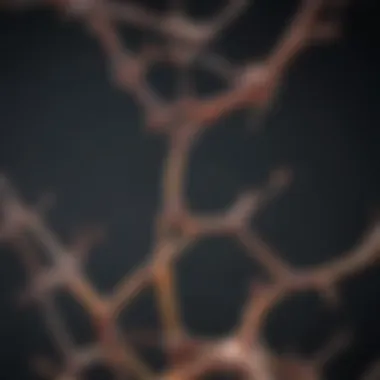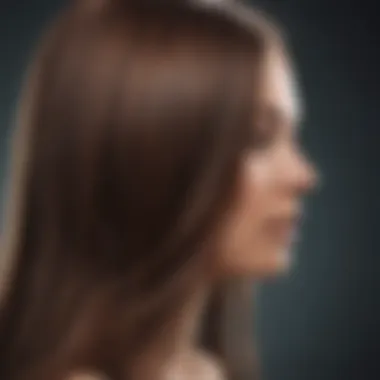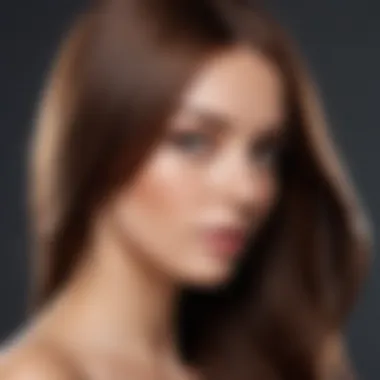Benefits of Keratin for Healthy Hair


Intro
In the ever-evolving landscape of hair care, one ingredient has struck a chord with beauty enthusiasts and professionals alike: keratin. This fibrous protein is naturally found in our hair, skin, and nails, acting as a building block that contributes to the strength and shine of our strands. As we delve deeper into the world of keratin, we’ll uncover its myriad benefits for hair health, along with its place in contemporary hair treatment practices. Moreover, we will take an honest look at the effectiveness of keratin treatments across different hair types, so that informed decisions can be made for optimal hair care.
Throughout this guide, we will touch upon the biochemical structure of keratin, its natural occurrences, and the advantages it presents. Not to forget, we'll also highlight potential drawbacks to equip readers with a balanced perspective. After all, understanding the ins and outs of keratin can lead to better hair care choices, reflecting the unique needs of each individual.
Let’s start this exploration by examining the fascinating characteristics of keratin and its role in promoting vibrant hair health.
Understanding Keratin
Keratin is more than just a buzzword tossed around in salon conversations. For anyone interested in hair care, grasping the essence of keratin is fundamental. This section is set to explore its pivotal role in hair health, emphasizing how this natural protein enhances the quality, strength, and overall appearance of hair. Given that hair is susceptible to damage from environmental elements, chemical treatments, and everyday wear-and-tear, understanding keratin provides insights into how we can maintain and enhance our hair.
What is Keratin?
At its core, keratin is a fibrous structural protein found in the cells that make up hair, skin, nails, and even feathers. It acts as a protective shield, bolstering the hair’s durability against physical and chemical damage. Unlike other proteins in our body, keratin is unique in its tough composition. It is primarily composed of amino acids, which connect to form long chains, resembling a ladder. This structure gives it its strength and resilience. In simpler terms, think of keratin as a sturdy frame that keeps your hair looking luscious and healthy.
"Keratin works like armor on our hair, guarding it against the daily rigors."
Types of Keratin
In studying keratin, it’s crucial to recognize that not all keratin is created equal. There are two primary types: soft keratin and hard keratin. Soft keratin is generally found in hair and skin, offering flexibility. Hard keratin, in contrast, is present in nails and certain outer layers of skin, providing strength and protection. Hair predominantly comprises a type of hard keratin known as alpha-keratin. This specific keratin type is pivotal in ensuring that hair strands are both strong yet flexible enough to withstand styling and environmental stressors.
Furthermore, keratin can be categorized based on its source. Natural keratin can be harvested from animals, such as sheep wool, while synthetic versions are created from various proteins. Understanding these distinctions can guide choices in hair products and treatments.
Biochemical Properties of Keratin
Delving into the biochemical realm, keratin possesses remarkable properties that contribute to its functionality. Its unique structure allows it to be resilient against heat, chemicals, and wear. Keratin’s molecular configuration features sulfur bonds, which provide stability and strength. The presence of disulfide bonds between keratin strands is noteworthy because these bonds can affect hair’s texture and curl patterns. For instance, hair that has more disulfide bonds tends to be curlier and more prone to frizz.
Moreover, keratin absorbs moisture, crucial for maintaining hair suppleness. In a healthy state, this protein ensures that hair remains hydrated, reducing brittleness and breakage. Consequently, knowing the biochemical makeup of keratin helps in understanding its significant place in hair care formulations. Without diving too deep into technicalities, it’s safe to say that these properties are the backbone that holds our hair structures together.
The Role of Keratin in Hair Structure
The signaling role of keratin in maintaining healthy hair cannot be overstated. Keratin, being the primary structural protein of hair, skin, and nails, acts as a powerhouse of strength, durability, and flexibility in this context. Understanding its intricate role is essential not just for those looking to improve their hair's appearance but also for anyone aiming to enhance its overall health.
Protein Composition of Hair
Hair is predominantly composed of keratin, which contributes approximately 95% of its structure. This fibrous protein is a complex arrangement of amino acids. Among these, cysteine is crucial as it forms disulfide bonds that link keratin fibers together, imparting strength and resilience to hair strands.
Moreover, the arrangement of keratin proteins can vary. For instance, alpha-keratin is more flexible and is found in human hair, whereas beta-keratin, which is sturdier, is prevalent in bird feathers and reptiles. Understanding these involved mechanics can help one appreciate the unique properties of their own hair.
Keratin’s Contribution to Hair Strength
Keratin not only serves as a framework but also significantly contributes to the overall strength of hair. The tightly woven matrix created by keratin molecules lends hair its tensile strength, enabling it to withstand everyday wear and tear, from styling to environmental damage. A hair strand can often resist an impressive amount of force more than most individuals realize.
Moreover, keratin treatments can help repair damage caused by chemical processes or heat styling, effectively filling gaps in the hair structure left by these harsh methods.
"A single strand of hair is surprisingly strong; it can support the weight of an entire pencil. When maintained with keratin, its strength knows no bounds."
Maintaining Hair Elasticity
Elasticity is an essential property of hair, enabling it to stretch and bounce back without breaking. Keratin plays a pivotal role in this regard as well. A well-structured keratin composition allows hair to maintain its shape even after exposure to stressors. It provides a cushion, allowing hair to resist breakage during styling, washing, and exposure to the elements.
When hair loses its natural keratin content, often due to environmental factors or harsh treatments, its absorptive capacity decreases, leading to dryness and brittleness. Consequently, incorporating keratin into one’s hair care routine can help restore this vital protein, enhancing not just appearance but also overall vitality.


In summary, understanding the role of keratin in the structure of hair emphasizes its importance in achieving and maintaining healthy, vibrant locks. From composition to strength and essential elasticity, keratin fulfills multiple functions that can truly transform hair health.
Benefits of Keratin for Hair
In today's beauty landscape, keratin stands out as a vital component for maintaining and enhancing hair health. Millions are turning to keratin treatments, often seeking that coveted shiny, smooth mane. The benefits of keratin extend beyond mere aesthetics; they touch upon the foundations of hair structure and overall resilience.
Both curly and straight hair types boast unique needs, and keratin offers a tailored solution. Whether you battle dryness, damage, or unruliness, understanding keratin can open up new avenues for care. In this section, we'll explore three key advantages: enhancing shine and smoothness, reducing frizz and flyaways, and improving manageability.
Enhancing Shine and Smoothness
Shiny, smooth hair isn’t just a trend—it's a sign of healthy hair. Keratin contributes greatly to this luster. This protein fills in the gaps in the hair cuticle, creating a smoother surface that reflects light more effectively.
- Keratin treatments often coat hair strands, leading to an instant transformation. You'll notice a significant difference even after the first application.
- The gloss from keratin isn’t a temporary fix; it's about strengthening the fibers beneath. Over time, this leads to natural shine as hair becomes healthier.
Using keratin-infused shampoos and conditioners can also maintain this sheen. While these products may not be as potent as salon treatments, they still provide essential nourishment that prevents future dullness.
"A little shine goes a long way—smooth hair is always in style."
Reducing Frizz and Flyaways
Frizz and flyaways can turn a good hair day sour in an instant. Humidity, dry air, and damage are usual suspects in this troubling equation. Luckily, keratin comes to the rescue. It helps to seal and smooth the hair cuticle.
- When hair is treated with keratin, it becomes less porous. This means moisture gets locked in, while environmental factors struggle to wreak havoc.
- Regular use of keratin treatments means fewer flyaways. Those pesky strands that refuse to behave? They can be tamed when your hair has the right level of hydration and protection.
Investing in keratin is investing in peace of mind. When you step out the door, knowing your hair won’t frizz at the first sign of moisture gives a lift to your spirits.
Improving Manageability
Managing hair can feel like an uphill battle, especially for those with thicker or curlier textures. Keratin's role here is substantial. By replenishing the protein levels in your hair, it transforms how your tresses behave.
- After a keratin treatment, many notice that styling becomes less of a chore. Tools glide more easily through the hair, reducing the time and effort spent on styling.
- For those blessed with natural curls, keratin can help define and soften those locks, making them more pliable while still keeping the wave or curl intact.
Ultimately, improved manageability means fewer bad hair days. With hair that’s easier to style, individuals can embrace their natural beauty without the frustration of taming unruly strands.
Keratin treatments are not just a superficial solution; their benefits resonate through enhanced shine, reduced frizz, and improved manageability. By choosing keratin, you're opting for healthier hair—something that will shine through every time you step out.
Keratin Treatments in the Market
In recent years, keratin treatments have surged in popularity, capturing the attention of many seeking to improve their hair's health and appearance. Understanding this topic is crucial as it sheds light on various treatment options, their effectiveness, and overall benefits. As we explore keratin treatments, it becomes clear that not all products or approaches are created equal. Choosing the right keratin treatment can significantly affect your hair’s texture, shine, and manageability. Here, we will break down the key options available in the market, compare salon treatments with at-home products, and provide guidance on selecting the suitable treatment for your unique hair needs.
Overview of Treatment Options
When considering keratin treatments, you’ll find a multitude of options to choose from. Here’s a quick glance at the major categories:
- Professional Salon Treatments: These often deliver the most dramatic results. Professional stylists apply high-quality keratin formulas that penetrate deeply into the hair shaft, offering long-lasting smoothness. Common salon treatments include Brazilian Blowouts and Keratin Express.
- At-Home Treatment Kits: For those preferring the DIY route, various brands offer at-home solutions. While these typically contain lower concentrations of keratin, they can still provide noticeable improvements over time. Some popular products include Garnier Fructis Sleek & Shine and TRESemmé Keratin Smooth.
- Keratin-Infused Hair Products: Shampoos, conditioners, and hair masks enriched with keratin can contribute to enhanced hair health. These products act more as a maintenance tool rather than a complete treatment.
Each option has its advantages and downsides, and understanding what you're looking for is key to making an informed choice.
Salon Treatments vs. At-Home Products
The debate between salon treatments and at-home products is a hot topic among hair enthusiasts. Salon treatments often provide immediate, striking results, but they come at a price. A visit to a salon can be costly, typically ranging from $150 to $500 depending on geographical location and the stylist's expertise. However, the results can last anywhere from three to six months, which can justify the expense for many.
On the other hand, at-home treatments offer affordability and the convenience of applying whenever it suits you. They tend to be safer on the wallet, often costing less than $50. Yet, the results may not compare to professional treatments, requiring consistent use over time to see real benefits. Ultimately, the choice comes down to budget, time, and desired outcomes.


Choosing the Right Treatment
Selecting the right keratin treatment can feel overwhelming, given the plethora of options on the market. Here are some critical factors to consider:
- Hair Type: Fine hair may benefit from lighter formulas, while thicker, curlier hair often requires more potent treatments. Knowing your hair type will steer you towards a suitable product.
- Desired Results: Whether you're looking to reduce frizz, achieve sleek styles, or restore damaged strands, there's a treatment tailored for each need. Be clear about your goals.
- Ingredient Scrutiny: It's essential to check for potentially harsh chemicals in keratin treatments. Some products contain formaldehyde, which can cause health concerns. Seek options that are free from these ingredients.
- Aftercare Requirements: Many salon treatments necessitate specific aftercare routines, like using sulfate-free shampoos. Understanding these conditions ahead of time will help maintain results.
Ultimately, personal research and perhaps even consulting with a hair care professional will increase the chance of selecting a keratin treatment that aligns with your hair goals.
In summary, navigating the landscape of keratin treatments involves weighing different aspects: effectiveness, cost, and suitability for your hair type. With the right information, you can make a confident choice that best serves your needs.
Assessing Keratin's Effectiveness
Understanding the effectiveness of keratin treatments is crucial for anyone looking to enhance their hair health. Keratin, being a primary structural component of hair, plays a significant role in determining not just the aesthetics but also the strength and resilience of our strands. Evaluating its effectiveness involves several layers, from comparing it with alternative treatments to understanding how individual factors can sway results.
Comparing Keratin with Other Treatments
When it comes to hair care, keratin treatments often square off against other popular methods like protein treatments and chemical relaxers. Each treatment has its unique aspects and benefits.
- Keratin Treatments: These are designed to smooth and strengthen the hair. They can be particularly beneficial for those with wavy or frizzy hair types, leading to a sleek finish.
- Protein Treatments: These serve to fortify hair by restoring proteins; however, they can sometimes leave hair feeling stiff and straw-like if overused.
- Chemical Relaxers: These alter the hair texture permanently but can lead to dryness and damage if not used cautiously.
Keratin tends to provide a balance, enhancing shine while minimizing damage, making it a favorite among many. But it’s essential to weigh your hair type and desired outcomes when considering these options.
Factors Influencing Results
Determining the effectiveness of keratin treatments isn’t black and white; several factors contribute to the outcome. Here are some that one must pay attention to:
- Hair Condition: Damaged or overly processed hair might respond differently to treatments compared to healthy hair.
- Application Technique: How the treatment is applied can impact results. A skilled stylist can make all the difference.
- Post-Treatment Care: The products used post-treatment and how often you wash your hair can influence how long you retain the keratin effects.
- Environmental Factors: Humidity and climate play a role in how hair behaves after treatment; in humid areas, the results may not last as long.
These varying conditions mean that results can greatly fluctuate from one person to another. Hence, a one-size-fits-all approach rarely applies in this context.
Hair Type Considerations
Different hair types react uniquely to keratin treatments, making it essential to consider your own texture and structure.
- Curly Hair: Often benefits the most from keratin treatments as they can help reduce frizz and enhance manageability.
- Straight Hair: May notice enhanced shine but could be wary of the weight added by keratin, potentially leading to limpness.
- Coarse Hair: This type may see transformative results, turning unruly locks into smooth, glossy strands.
- Fine Hair: Caution is advised here; too much keratin can leave hair looking flat or greasy.
Tailoring the treatment to specific hair types maximizes effectiveness, making a consultation with a professional worthwhile.
"Understanding your hair type is as critical as the treatment itself. Tailoring the approach can lead to notable changes in the health and look of your hair."
Potential Downsides of Keratin Treatments
When discussing hair health, it’s easy to get swept away by the allure of keratin treatments. They promise shiny, frizz-free hair that’s easy to manage. However, it’s crucial to also consider the potential downsides that may accompany these treatments. Understanding these risks can help individuals make informed decisions about their hair care options.
Chemical Components in Keratin Treatments
Most keratin treatments contain a variety of chemicals that can be concerning. Some popular formulas include formaldehyde or its derivatives, such as methylene glycol. These compounds are often used to create the straightening effect but come with their own set of risks. Prolonged exposure can be harmful, leading to respiratory issues, skin irritations, and other health problems.
It's worth noting that not all keratin treatments contain these harsh chemicals, but it’s essential for consumers to check the ingredient lists. Always read labels closely, because a product may sound safe but can hide potent components that could ultimately harm your hair or even your health.
Long-Term Effects on Hair Health
Though many users experience immediate benefits from keratin treatments, there is a growing body of evidence suggesting long-term use may lead to negative consequences. Over time, frequent treatments could result in hair becoming increasingly porous or brittle. Some may even report significant hair loss or thinning as their natural hair structure gets compromised.


Additionally, continuous application of keratin can lead to an over-reliance on the treatment, making it harder for natural hair to shine through. Clinical reports highlight cases where individuals have ended up with hair that requires continual styling to look presentable, which can be a slippery slope.
Allergic Reactions and Sensitivities
Another point of consideration is the risk of allergic reactions. Individuals may develop sensitivities to chemicals used in keratin treatments. Symptoms can range from mild irritations, like itching and redness, to severe reactions, which might include swelling or respiratory distress.
It’s advisable to perform a patch test before undergoing a full treatment, particularly for those with known allergies or sensitive scalps. Pay close attention to how your skin reacts to new products or services, as it could save you from a world of discomfort later on.
"Keratin treatments have their perks, but it’s crucial to stay informed about the potential downsides to avoid nasty surprises down the line."
In summary, exploring keratin treatments requires a balanced perspective. While the benefits can certainly enhance hair's appearance, awareness of the chemical components, long-term health implications, and potential allergic reactions is vital for making educated choices in hair care.
Natural Alternatives to Keratin Treatments
The growing awareness regarding hair care and wellness has led many to explore natural alternatives to keratin treatments. While keratin can work wonders for hair health, some individuals seek options that align better with their preference for plant-based or less chemically intensive products. This shift toward natural solutions is not just about avoiding chemicals; it comes from a desire to nourish hair in a holistic way, utilizing the power of nature to promote growth, strength, and vibrancy.
Plant-Based Proteins
Plant-based proteins are gaining traction as effective alternatives to traditional keratin treatments. Ingredients such as soy, quinoa, and wheat proteins offer reparative properties without the harsh chemicals often found in synthetic products. These proteins can help to strengthen the hair shaft and reduce breakage, enhancing overall hair quality.
For instance, quinoa is a complete protein containing all essential amino acids, capable of nourishing the hair and adding vitality. When used in shampoos or conditioners, these proteins can penetrate the hair cuticle, providing deep hydration. The beauty of such alternatives lies in their ability to also appeal to those with sensitive scalps or allergies to chemicals.
Essential Oils and Nourishing Creams
Essential oils also play a pivotal role in the natural hair care arsenal. Oils such as argan, jojoba, and coconut are often thrown into the mix for their moisturizing and protective qualities. Using essential oils can enhance the shine and health of hair, acting as a natural leave-in conditioner that maintains moisture and softness.
Nourishing creams infused with these oils generally improve flexibility and reduce frizz, which is often exacerbated by environmental factors. The combination of essential oils and nourishing ingredients can create a barrier against damage while promoting growth without resorting to heavy treatments.
Comparative Benefits
Comparing natural alternatives to keratin treatments reveals a broader picture of hair care. Here are some key factors to consider:
- Gentler Ingredients: Natural alternatives tend to contain fewer harsh chemicals, making them suitable for daily use.
- Holistic Approach: They complement a wider skincare regime, integrating better with an overall wellness routine, including diet and lifestyle.
- Environmental Impact: Plant-based solutions often have a lower environmental footprint compared to synthetic treatments.
- Diverse Choices: From oils to creams, the variety provides options that can cater to different hair types and textures.
"Understanding the needs of your hair is crucial, as natural alternatives can often provide targeted benefits depending on its unique requirements."
Closure and Recommendations
The exploration of keratin's impact on hair health reveals a multifaceted narrative steeped in both benefits and considerations. Throughout this article, various aspects of keratin have been dissected, from its essential role in the structural integrity of our hair to the different modalities of treatment available on the market. Understanding these components is crucial, as it empowers readers to make informed choices tailored to their unique hair care needs.
Keratin, being a natural protein, is central to promoting smoothness and elasticity in hair. The keratin treatments available today, whether from salon professionals or at-home products, promise to transform often frizzy, unmanageable locks into silk-like strands. However, one must weigh these benefits against potential drawbacks, such as the presence of harmful chemicals in some treatments. It’s this balance that provides a comprehensive understanding of keratin’s role in the pursuit of healthy hair.
Summarizing Key Insights
In summarizing the significant insights offered, it becomes clear that:
- Keratin is vital for hair health: It is a natural component that contributes to strength, length, and overall appearance of hair.
- Treatments can provide notable improvements: Options such as keratin smoothing treatments can lead to shinier and more manageable hair.
- Considerations matter: The safety profile of treatments may vary, entailing the need to approach each option with a critical eye.
- Tailor your approach: What works for one hair type may not suit another, so understanding your own hair's needs is paramount.
These insights serve as a foundation for readers to assess their hair health goals and consider keratin treatments, weighing their options with care and research.
Final Thoughts on Keratin for Hair Health
Ultimately, the world of keratin is vast and, to some extent, intricate. For many, the benefits of keratin treatments can alleviate common hair woes, such as frizz and breakage. Think of keratin as a shield; while it can protect and enhance, it's essential to remember that not all treatments are created equal.
Investing time in finding the right product or professional service aligned with individual hair needs can lead to rewarding outcomes. As with all beauty choices, personal experience will guide one’s preferences, and it may take some trial and error to discover the best path. Therefore, don’t shy away from voicing concerns or asking questions when selecting a keratin treatment. After all, healthy hair is not just a luxury, it is an achievable standard.
"Investing in your hair is not an expense; it’s an investment in your confidence."
Thus, embracing the benefits of keratin for your hair health can lead to a transformation, provided you navigate the options wisely. Each individual's journey toward vibrant hair will undeniably differ, but informed decisions pave the way for that journey.







